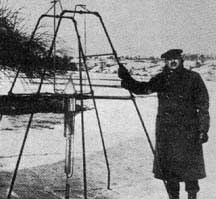Robert Goddard 
(1882 - 1945 AD) American physicist who is looked upon as one of the three main founders of modern rocketry, along with Tsiolkovsky and Oberth. Goddard launched the first liquid-fueled rocket on March 16, 1926. The flight lasted just 2.5 seconds, reaching an altitude of 12.3 meters and landing (crashing, actually) 55.2 meters from the launch site in his Aunt Effie's cabbage patch. In 1920, the Smithsonian Institution published Goddard's paper on rocket concepts, "A Method of Reaching Extreme Altitudes." Towards the end of his article, Goddard began to hint at his thoughts for the future by detailing his plans for launching a small, unmanned rocket that would be sent to Earth's Moon, wherein it would strike the surface and explode its payload of flash powder, so that observers with telescopes could see where the rocket had landed. Goddard was cautious not to mention flights to Mars or any other planet, as any celestial object beyond the Moon was considered by many scientists at that time to be too far away from Earth to ever be reached by humans. Goddard suddenly found himself ridiculed by the press. The prestigious New York Times dismissed Goddard's ideas and said that he didn't even possess an elementary knowledge of physics. The Times' editor incorrectly thought that rockets could not work in space. He thought the exhaust from the vehicle would have nothing to push against; he did not realize that the rocket exhaust would be acting against the inner walls of the rocket itself, thus creating the required reaction. Luckily, aviator Charles Lindberg took an interest in Goddard's concepts and decided to help finance his work on rockets. Lindberg also convinced philanthropist Daniel Guggenheim to help fund Goddard and move his entire operation to Eden Valley near Roswell, New Mexico. There, Goddard could test his new developments in the comparative safety and peace of the wide open desert. Here in the desert, Goddard did some of his best work, testing parachute systems to recover rockets and their payloads, constructing stabilizing fins and gyroscopes to keep rockets flying straight, and even putting simple meteorological instruments aboard some flights to study the weather. Despite all this work, Goddard and his rockets were generally unknown to the American public, and many of his ideas went unrecognized until several decades after his death in 1945. Ironically, his ideas did not go unnoticed by the Germans, particularly Wernher von Braun who took Goddard's plans from various journals and incorporated them into building the A-4 series of rockets--better known as the V-2--which constantly struck at Europe in the last two years of World War Two. The Army also adopted only one major and direct facet of Goddard's concepts in his lifetime, the antitank weapon known as the bazooka. Eventually, the United States Patent Office would posthumously recognize 214 patents in all for various rocket designs invented by Goddard. Every liquid-fueled rocket that flies is based on Goddard's original innovations. **The preceding information is provided by the Eric Weisstein's World of Scientific Biogra.** |